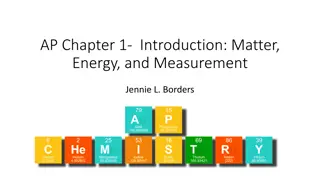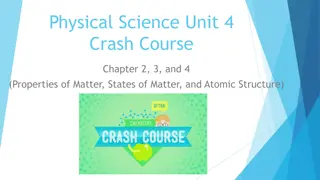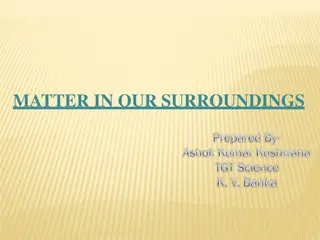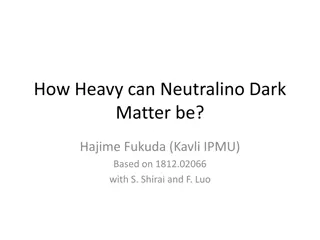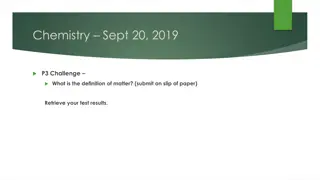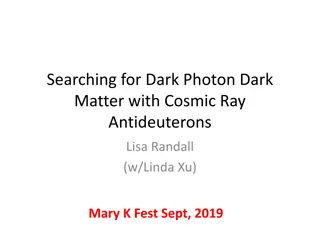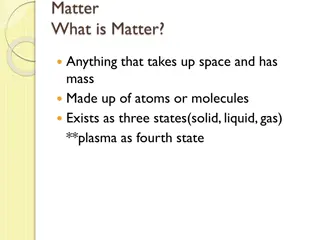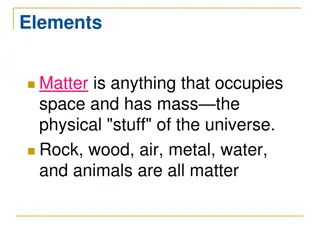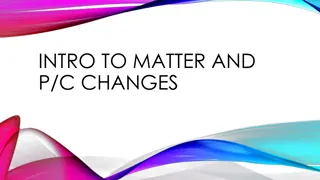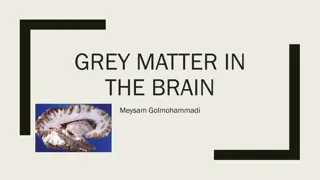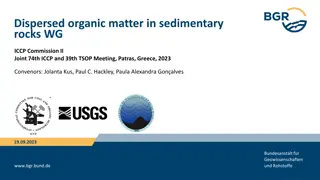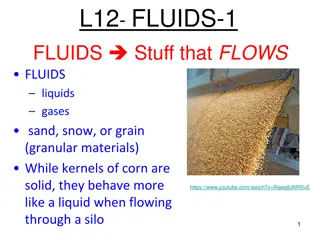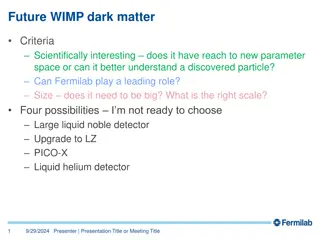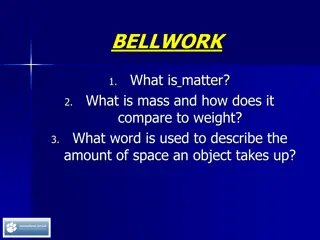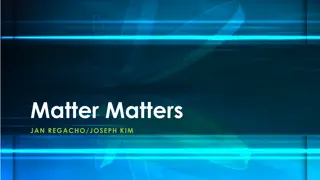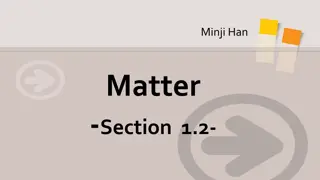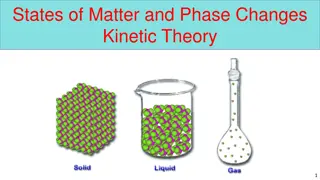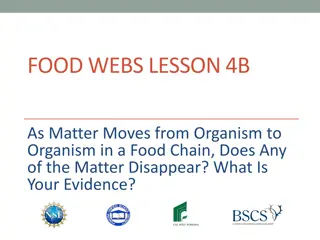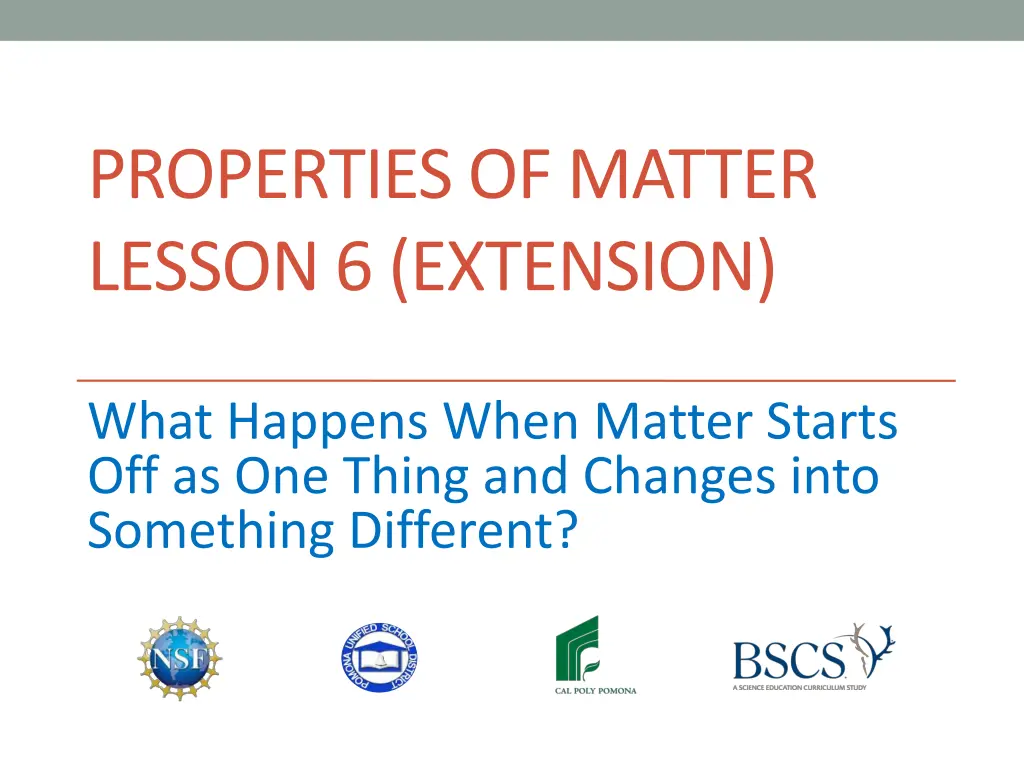
Matter Transformation and Molecular Changes Explained
Explore the fascinating process of matter changing from one form to another. Discover how molecules behave when transitioning between solid and liquid states through interactive human models. Key science concepts and examples of matter changes are also highlighted in this engaging lesson extension.
Download Presentation

Please find below an Image/Link to download the presentation.
The content on the website is provided AS IS for your information and personal use only. It may not be sold, licensed, or shared on other websites without obtaining consent from the author. If you encounter any issues during the download, it is possible that the publisher has removed the file from their server.
You are allowed to download the files provided on this website for personal or commercial use, subject to the condition that they are used lawfully. All files are the property of their respective owners.
The content on the website is provided AS IS for your information and personal use only. It may not be sold, licensed, or shared on other websites without obtaining consent from the author.
E N D
Presentation Transcript
PROPERTIES OF MATTER LESSON 6 (EXTENSION) What Happens When Matter Starts Off as One Thing and Changes into Something Different?
How Can Matter Change? What happens to the molecules when a solid changes to a liquid? What happens to the molecules when a liquid changes to a solid? Photos courtesy of BSCS
A Human Model of Matter Today you ll become human models of matter! As models of water molecules, you ll act out what happens when a solid changes to a liquid and a liquid changes to a solid. How would you move if you were a water molecule?
A Human Model of Matter In your group, come up with a plan for acting out how water molecules behave in a solid and a liquid. Make these decisions: How close should we stand as molecules of solid water and liquid water? How should we all move as molecules of solid water and liquid water?
A Drop of Water Let s read about water molecules! Photo courtesy of BSCS
Key Science Ideas Heating (melting) and removing heat (freezing) can cause changes in matter. Matter changes from a solid to a liquid when heat is added and the molecules move around more freely. Matter changes from a liquid to a solid when heat is taken away and the molecules slow down and vibrate in place.
Todays Focus Question What happens when matter starts off as one thing and changes into something different?
Examples of Changes in Matter Photos courtesy of BSCS
Our Lego Model Photo courtesy of BSCS H2O = Water More than one Lego brick = One molecule
Vinegar and Baking Soda What happened in lesson 1 when we mixed vinegar with baking soda in a plastic freezer bag?
A Baking-Soda Molecule This is a Lego model of a baking-soda molecule: Photo courtesy of BSCS How is this molecule like a water molecule? How is it different?
A Baking-Soda Molecule A baking-soda molecule has six atoms. Two atoms are the same as the atoms in water (hydrogen and oxygen), and two are different. Photo courtesy of BSCS
A Vinegar Molecule This is a Lego model of a vinegar molecule: Photo courtesy of BSCS How is this molecule different from a baking- soda molecule?
A Vinegar Molecule A vinegar molecule is bigger than a baking-soda molecule with a total of eight atoms. But it has only three different kinds of atoms. Photo courtesy of BSCS
Your Predictions What do you think will happen to these molecules when we mix the vinegar and the baking together? Vinegar Molecule Baking-Soda Molecule Photos courtesy of BSCS
Physical and Chemical Changes Physical Change Add Heat Remove Heat Chemical Change Photos courtesy of BSCS
Lets Summarize! Today s focus question: What happens when matter starts off as one thing and changes into something different? Turn and Talk: Share your ideas with an elbow partner. Then write your best answer to this question in your science notebook using 1 or 2 complete sentences. Listen carefully and ask questions to help each other come up with clear answers that include science words and ideas about matter.
Atoms and Molecules Today we started with 2 types of molecules (baking soda and vinegar) and ended up with 3 new molecules! If we can end up with a different number of molecules in a chemical change, can the number of atoms change too? Think about this question. Then share your ideas with an elbow partner using this sentence starter: I think the number of atoms [can/can t] change because ____________.
Next Time In our next lesson, we ll talk more about whether the number of atoms can change like the number of molecules in a chemical change. Then we ll see if our ideas match the ideas of scientists.

